Cooper (DD-695)
1944
Elmer Glenn Cooper—born in Monticello, Ark., on 9 May 1905 to James O. and Anna Bell (Manee) Cooper—attended Monticello High School; Hall’s School, Columbia, Mo.; and Branham and Hughes School, Springhill, Tenn., before he entered the U.S. Naval Academy, appointed by Sen. Joseph Taylor Robinson of Arkansas on 3 July 1923. Cooper graduated on 2 June 1927.
Remaining at the Naval Academy until 14 July 1927, Cooper completed instruction in aviation before reporting for duty in battleship Maryland (BB-46) on 26 August. He was commissioned ensign on 6 March 1928. Three months later, on 6 June 1928, Cooper married Frances Vivian Lewis Sigmon of Little Rock, Ark. Detaching from the battleship in early November, he next served in submarine tender Holland (AS-3) until 29 May 1929 and then in destroyer Moody (DD-277) through 7 January 1930.
Cooper commenced flight training at Naval Air Station (NAS) Pensacola, Fla., on 30 January 1930. Promoted to lieutenant (junior grade) effective 2 June, Cooper earned his aviator wings on 2 October 1930. He remained at Pensacola until 7 November and then joined Torpedo Squadron (VT) 1 in the aircraft carrier Lexington (CV-2) on 13 December.
On 31 May 1932, Cooper transferred to Scouting Squadron (VS) 6B embarked in the light cruiser Concord (CL-10). During his tour in that ship, Mrs. Cooper gave birth to a son, Glenn Martin, on 14 September 1932, in San Diego, Calif. Cooper’s next assignment brought him to the U.S. Fleet Air Base, Coco Solo, in the Panama Canal Zone, reporting to Patrol Squadron (VP) 3F on 30 June 1933. He then served with Bombing Squadron (VB) 2B in Saratoga (CV-3) from 24 June 1935. Cooper advanced to the rank of lieutenant effective 1 July 1936.
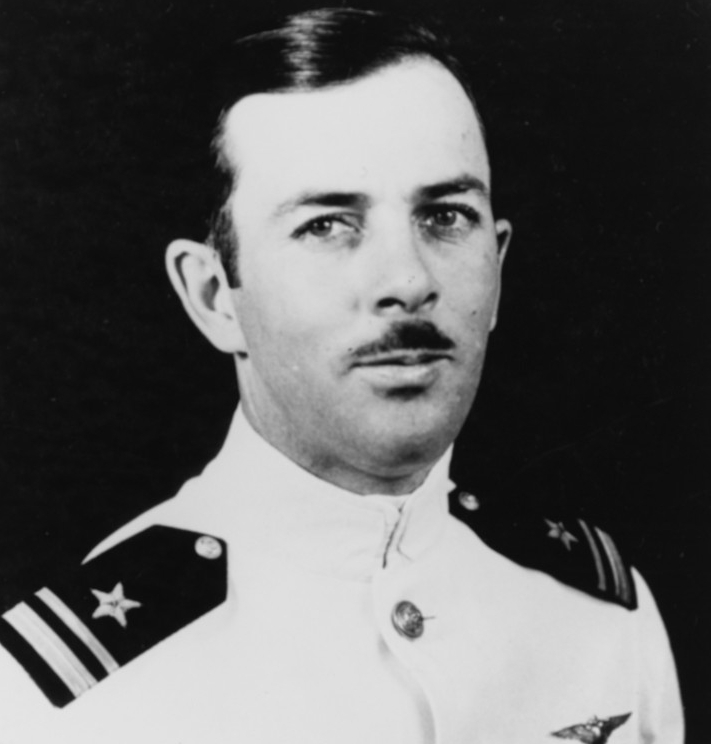
On 11 January 1937, Cooper joined VP-11F based at NAS North Island, San Diego, Calif. Less than a year later, on 2 February 1938, he was at the controls of 11-P-3, a Consolidated PBY-2 Catalina (BuNo 0462), participating with his squadron in the first day of a fleet exercise approximately 70 miles west of San Diego, south of San Clemente Island. While flying into a tight formation in the dark during a sudden rain squall, Cooper’s flying boat collided with 11-P-4 (BuNo 0463), piloted by Lt. Carlton B. Hutchins. Bursting into flames, 11-P-3 plunged into the Pacific, claiming the lives of Cooper and his six crewmen. Hutchins was able to keep his plane aloft long enough to enable four of his six-man crew to exit the doomed PBY, although one of these men died from his injuries the next day.
With 11 fatalities and only three survivors, the collision was at that point in time the worst disaster involving an airplane in the history of the U.S. Navy. Cooper’s body was never recovered.
(DD-695: displacement 2,200; length 376'6"; beam 40'; draft 15'8"; speed 34 knots; complement 336; armament 6 5-inch, 12 40-millimeter, 11 20-millimeter, 10 21-inch torpedo tubes, 6 depth charge projectors, 2 depth charge tracks; class Allen M. Sumner)
Cooper (DD-695) was laid down on 30 August 1943 at Kearny, N.J., by Federal Shipbuilding & Dry Dock Co.; launched on 9 February 1944; and sponsored by Mrs. Frances Sigmon Cooper, widow of the ship’s namesake.
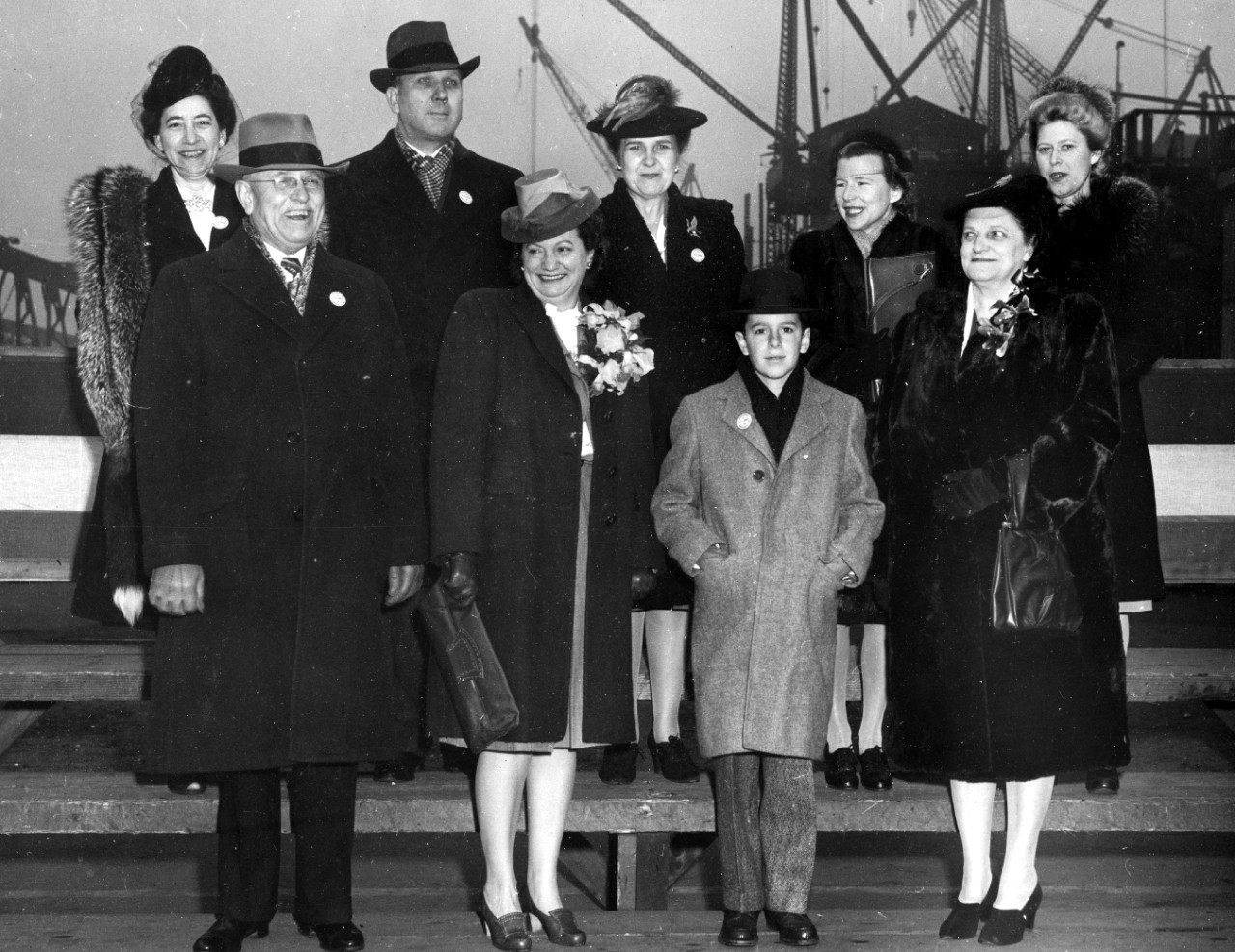
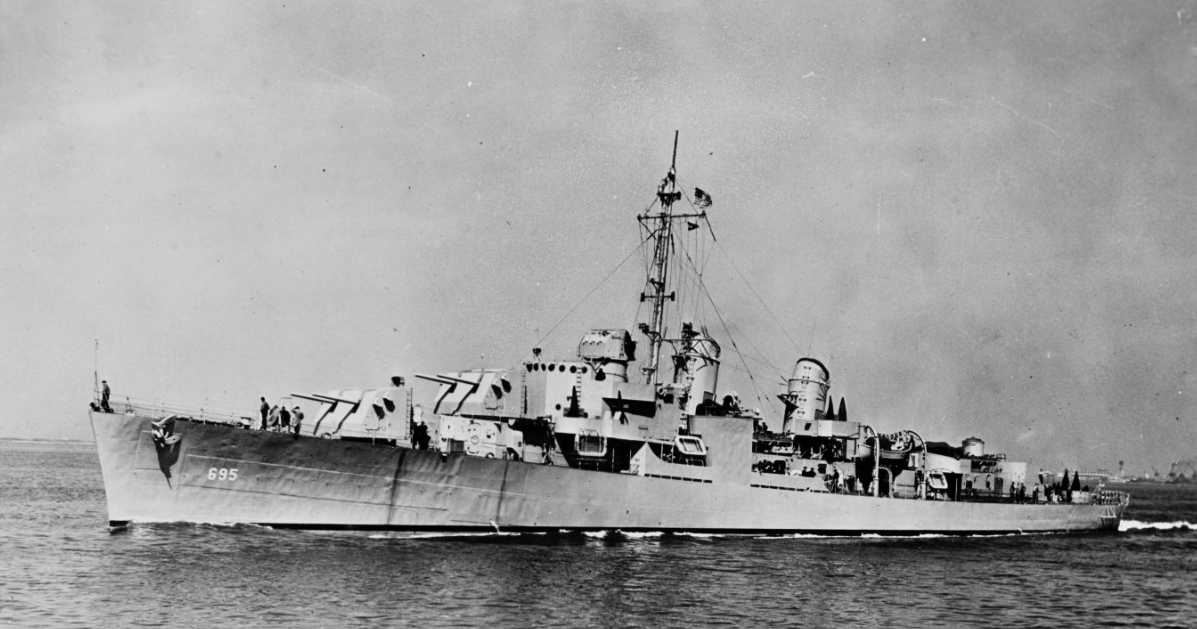
Commissioned at the New York Navy Yard, Brooklyn, N.Y., on 27 March 1944, Cmdr. John W. Schmidt in command, Cooper received assignment to Destroyer Squadron (DesRon) 60, Destroyer Division (DesDiv) 120, and remained at New York for several weeks for fitting out and sea trials. On the morning of 20 April 1944, Cooper sailed for Bermuda, joining the escort vessel Corbesier (DE-438) shortly after departure.
After arriving at midday on the 22nd, the new warship began shakedown activities and operational training with the Destroyer-Destroyer Escort Shakedown Task Group (TG 23.1), Squadron Zebra, which also included Blue (DD-744) and De Haven (DD-727). During her month-long shakedown, Cooper engaged in operational training exercises in communications, combat information center operations, gunnery, engineering, damage control, towing, fueling at sea, torpedo firing, and antisubmarine tactics.
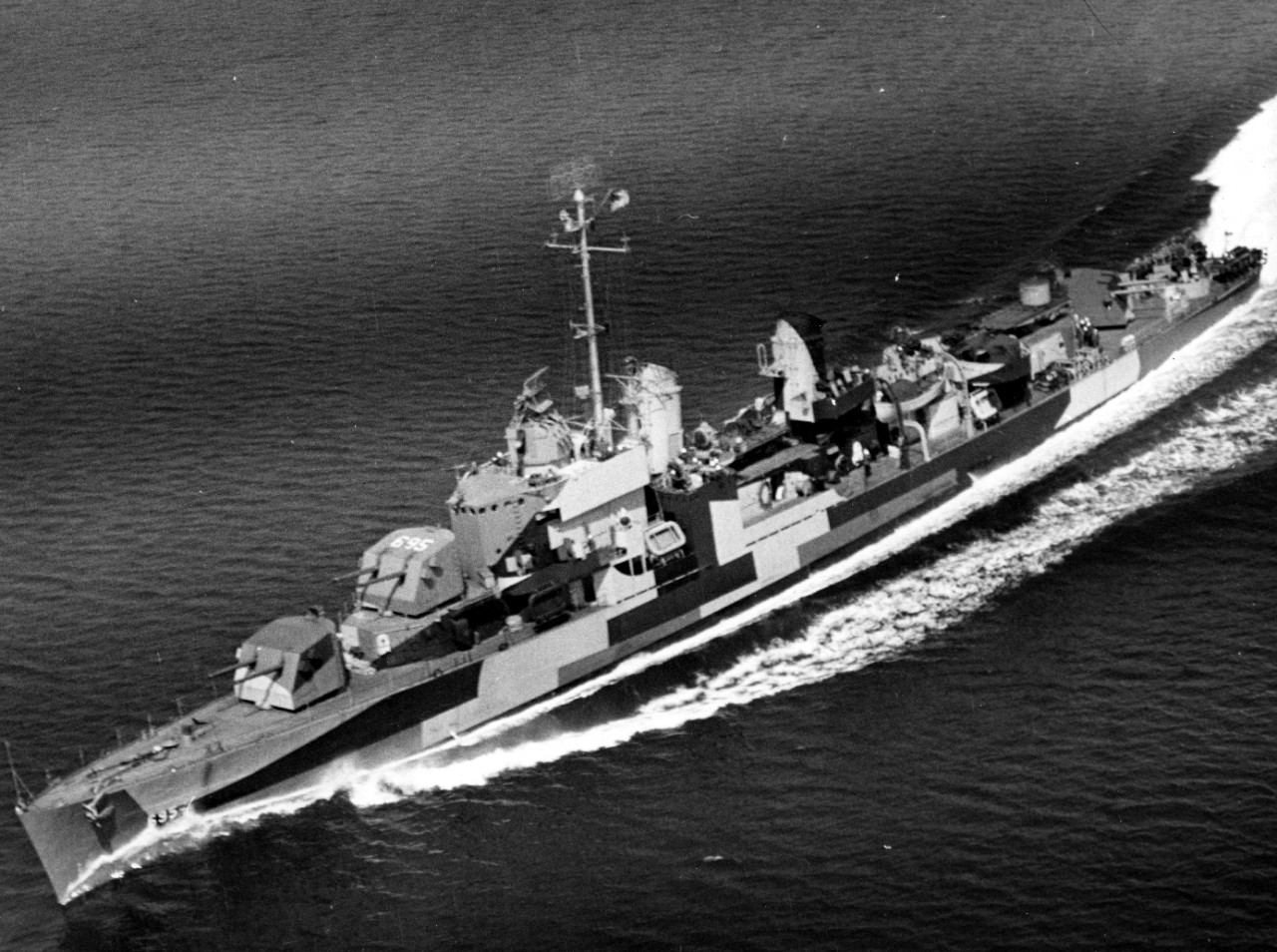
Departing Bermuda on 22 May 1944, Cooper sailed to Hampton Roads, Va., where she conducted training with destroyer precommissioning crews at Naval Operating Base (NOB) Norfolk beginning on the 26th. In company with Blue on 27 May, Cooper completed bombardment practice at Bloodsworth Island in Chesapeake Bay. On the 29th, the destroyer steamed to the Naval Research Laboratory at Chesapeake Beach, Md., where Cooper and Trippe (DD-403) spent several days conducting radar jamming experiments before returning to NOB Norfolk on 3 June. She returned to the bay again on 6 June for an antisubmarine exercise.
Sailing for New York on 10 June 1944, Cooper put in to the New York Navy Yard the next day and commenced a post-shakedown availability to complete major alterations of her bridge and superstructure. While the vessel lay in dry dock (26 June–6 July), Cooper held a ceremony on 30 June during which Mrs. Frances Cooper, her sponsor, presented the ship’s bell to the crew of the destroyer named in honor of her late husband. Departing the yard on the morning of 17 July, Cooper called at Gravesend Bay, N.Y., to load ammunition and then moored at the deperming station at the New York Navy Yard Annex at Bayonne, N.J. The following day, the destroyer steamed into Long Island Sound and completed magnetic compass compensation and radio direction finder calibration.
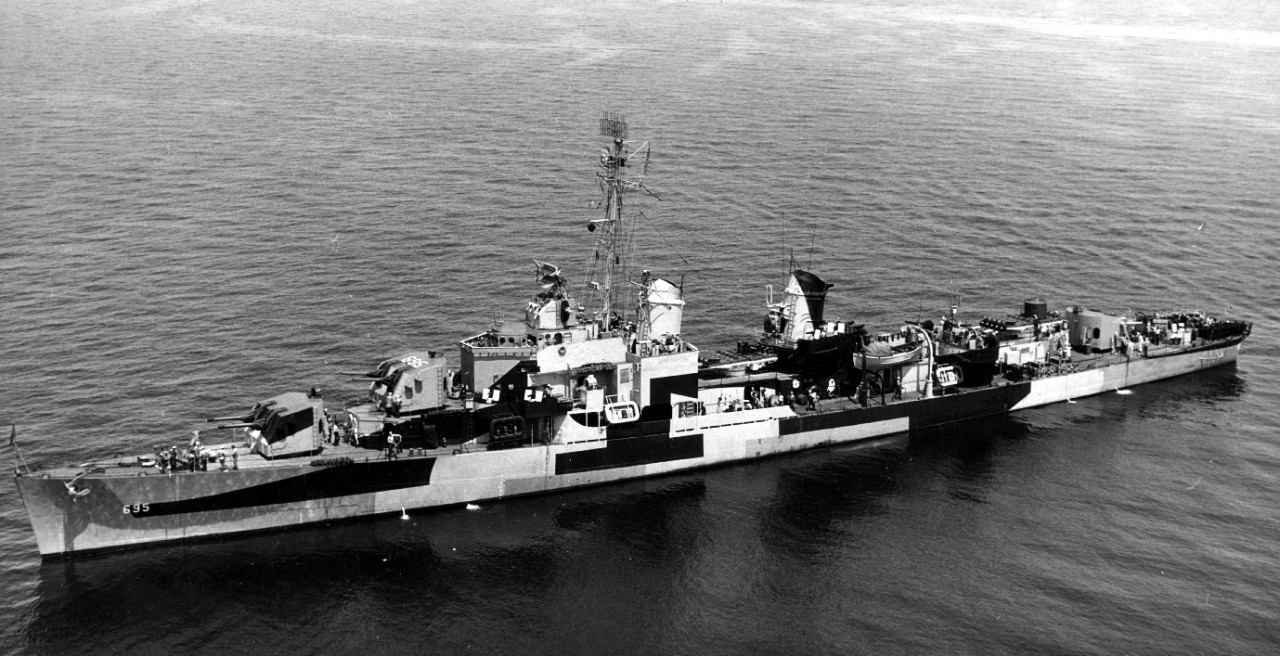
While engaged in these procedures, however, a casualty to her main circulating pump put her starboard engine out of commission, compelling Cooper to return to New York Navy Yard that evening for emergency repairs. With the additional work completed on the 21st, the destroyer set off once again, arriving the following day at the Washington Navy Yard, Washington, D.C., for inspection by representatives of the Bureau of Ships. Departing on the morning of the 27th, Cooper exercised in antisubmarine tactics with the French submarine Argo in the Montauk Point (N.Y.) training area in Long Island Sound before continuing on to Boston, arriving on 30 July.
At Boston, Cooper reported to TG 27.1, consisting of aircraft carrier Hancock (CV-19) and destroyers Lyman K. Swenson (DD-729) and Brush (DD-745). On 31 July 1944, the task group commenced its journey to the Pacific. After an overnight stop at NOB Norfolk (2–3 August), the convoy set off for the Panama Canal Zone. During flight operations on the morning of 5 August, Cooper rescued pilot Ens. Albert Rosen, USNR, and his radioman ARM3c Henry W. Hartigan, USNR, after their Curtiss SB2C-3 Helldiver (BuNo 18612) splashed astern of Hancock while trying to land. That afternoon, Lyman K. Swenson went to assist when another plane crashed ahead of the carrier. Less than ten minutes later, a third Helldiver (BuNo 18662) went down five miles ahead of Cooper, which shortly thereafter plucked Ens. John H. Shepley, USNR, and ARM3c John E. Ramsdell Jr., USNR, from the sea.
The warships arrived at Cristóbal, C.Z., on the afternoon of 8 August 1944. They transited the Canal that evening, mooring at Balboa on the Pacific coast before midnight. Now designated TG 12.6, the task group resumed its journey on the 10th, steaming up the coast toward San Diego. Arriving at midday on 18 August, the ships spent several days at San Diego to refuel and reprovision. The group got underway again on the 23rd, cruising off the coast of southern California for a day while Hancock completed underwater sound measurement experiments to test propeller noise with the coastal patrol yacht Jasper (PYc-13) before setting off across the Pacific for Hawaii. Upon arrival at Pearl Harbor, T.H., on the morning of 30 August, the task group was dissolved.
Cooper operated out of Pearl Harbor for the next seven weeks, conducting a variety of operational training exercises to prepare for duty in theater with the Fleet. Typically working with one or more vessels, Cooper drilled in important skills including gunnery, antisubmarine tactics, torpedo handling and evasion, shore bombardment, antiaircraft firing, and battle tactics. Her fellow DesDiv 120 destroyers—flagship Allen M. Sumner (DD-692), Moale (DD-693), and Ingraham (DD-694)—arrived at Pearl Harbor on 14 and 15 September 1944, joining their sister ship for the final month of training. Additionally, from 7–12 October, Cooper received an availability alongside the destroyer tender Yosemite (AD-19). At the end of her training period on 21 October, Cmdr. Mell A. Peterson assumed command of the ship.
On the morning of 23 October 1944, Cooper cleared Pearl Harbor in company with her squadron-mates Barton (DD-722), Walke (DD-723), and Laffey (DD-724) of DesDiv 119 and Allen M. Sumner and Moale of DesDiv 120. DesRon 60 rendezvoused with the battleship North Carolina (BB-55) at 1530 and set course for the Marshall Islands. After touching at Eniwetok on 30 October, the task unit headed for Manus in the Admiralty Islands. On 2 November, however, the group received orders to proceed instead to Ulithi Atoll in the Caroline Islands, arriving on the morning of 5 November. After refueling and loading ammunition at Ulithi, Cooper and the destroyers of DesRon 60 departed that same afternoon and soon rendezvoused with TG 38.4, flagship Enterprise (CV-6).
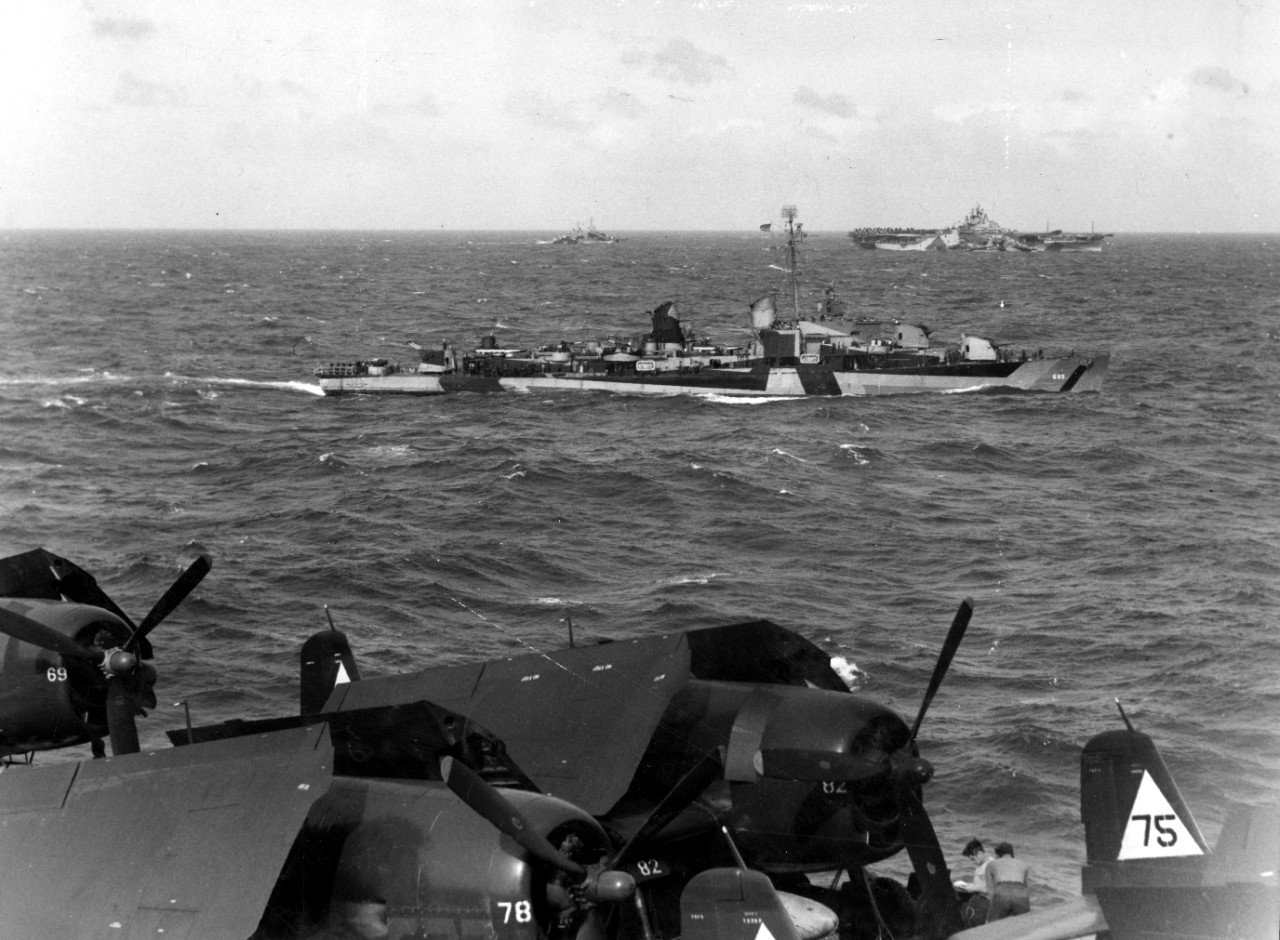
For the next several days, the task group steamed through strong winds and high seas as the warships sought to avoid an oncoming typhoon as they made their way toward the Philippine Islands. Finally, on the morning of 11 November 1944, the carriers of TG 38.4 launched their planes, striking at Japanese shipping in Ormoc Bay while the destroyers, including Cooper, screened the heavy vessels against enemy attack. After refueling at sea on the 12th, air strikes resumed at dawn on 13 November, this time targeting central and southern Luzon including Manila Bay. The task group aircraft conducted additional attacks on 14 and 19 November.
Cooper earned her only battle star for her actions off the Philippines during this period, including two aviator rescues on the afternoon of 19 November 1944. Serving as advanced strike picket ship for Task Force 38, at 1320 the destroyer steamed at 32 knots to a point off Luzon where two hours earlier a Grumman F6F-5 Hellcat (BuNo 70683) flying from Intrepid (CV-11) made a water landing after being hit by flak during an air strike on Nichols Field. Assisted by two planes from Hornet (CV-12) that circled the downed pilot’s position, and using radar to track the orbiting planes, Cooper picked up Lt. Frederick W. Tracey, A-V(N), USNR, of VF-18 at 1517.
During the rescue of Lt. Tracey, Cooper received another emergency signal from a position approximately 30 miles northwest. With the first pilot safely on board, the destroyer steamed to the second location, sending the two Hornet combat air patrol planes ahead to locate the downed pilot from VF-3 in Yorktown (CV-10). Earlier his Grumman F6F-5 Hellcat No. 33 (BuNo 58849) made a water landing after his engine failed due to damage from antiaircraft fire during air strikes over Luzon. At the scene, Cooper found Lt. Tom W. Lindsey, A-V(N), USNR, floating in a raft and rescued him at 1635.
Three hours later, Cooper spotted two bogies on radar 14 miles distant. Operating independently still far to the west of the task group and now without the benefit of cover from friendly aircraft, the ship attempted to establish communications with the planes, but only one, from Enterprise, responded. On radar, the two planes appeared to be making a coordinated torpedo attack on the destroyer’s bow, so Cooper advised the Enterprise pilot to change course. The second plane meanwhile continued its silent approach, and the destroyer determined that this was not a friendly contact. As the enemy plane advanced and made a low run over the ship, Cooper loosed five-inch rounds at the target but missed. The plane returned for a second close run before retiring in the darkness, but neither the plane nor the destroyer sustained any damage in the encounter.
After the eventful day on the 19th, Cooper temporarily joined TG 38.2 on the morning of 20 November 1944. The following day she rejoined TG 38.4 and refueled with oiler Marias (AO-57). On 22 November, the task group arrived at Ulithi, where Cooper completed rudder repairs (26–27 November). Upon completion of repairs on the 27th, Cooper got underway for Leyte Gulf in the Philippines, catching up with DesRon 60 which had departed earlier that morning. The squadron reached San Pedro Bay on the afternoon of the 29th and that night reported to TG 77.2, flagship Maryland (BB-46), to screen the heavy vessels while the task group patrolled Leyte Gulf.
Detached on the evening of 30 November 1944 to patrol on picket duty in the southern Surigao Strait, Cooper returned to the task group in Leyte Gulf on the afternoon of 1 December. One hour later, the heavy cruiser Minneapolis (CA-36) reported a torpedo wake. Shortly thereafter, Moale sighted a periscope in proximity to the battleship West Virginia (BB-48), which had assumed flagship status the previous day. New Mexico (BB-40) reported another torpedo wake 20 minutes later, and at 1730, Cony (DD-508) released depth charges over a sonar contact. Cooper took over the investigation of Cony’s contact at 1749 and dropped 22 more depth charges with no conclusive results. She returned to the task group at 1945, but after the flurry of possible undersea activity, Cooper was soon reassigned to patrol for enemy submarines near the eastern entrance to Leyte Gulf.
At 1829 on the evening of 2 December 1944, Cooper, Allen M. Sumner, and Moale received orders from the task force commander to proceed to Ormoc Bay on the western side of the island of Leyte. Acting on intelligence received that a convoy of five enemy ships was en route to the bay to land reinforcements, the ships of DesDiv 120 (less Ingraham) were to destroy any enemy vessels encountered, which would help pave the way for a planned American amphibious landing in the area later that month.
That night, the sea was calm and visibility good. Light from the rising full moon, diffused through a thin haze, illuminated the trio of destroyers as they sped toward Ormoc Bay. Just after 2300, southeast of Poro Island and less than an hour away from their destination, the formation had its first of many encounters with various Japanese aircraft. At 2308, Allen M. Sumner narrowly avoided a bomb that exploded off her starboard bow, although fragments from the projectile did cause several casualties, some structural damage, and a brief fire. The operational impact upon Allen M. Sumner proved minimal, however, and the destroyers pressed onward, with Allen M. Sumner in particular fighting off bogies as they maneuvered at 30 knots. Cooper fired at three of these planes, shooting down at least one.
Steaming in a bearing line at 1,500 yard intervals with the flagship Allen M. Sumner on the left flank, Cooper in the center, and Moale to starboard, the American warships entered Ormoc Bay around the start of the mid watch. Almost immediately they made radar contact with two surface targets, later identified as the Japanese destroyers Kuwa and Take, close to the shore. Facing their first test in surface combat, at 0003 Cooper and Allen M. Sumner opened fire on one target, thought to be either a troop transport or a destroyer, at 12,200 yards, and in mere minutes, this target was “in flames, thoroughly wrecked and sinking.” Cooper then turned her attention to the second Japanese vessel, now 10,000 yards distant, unloading on her until it became necessary to momentarily cease fire as Cooper passed the enemy ship to starboard, putting Moale, also firing at this target, in the line of fire. Salvos from the American gunnery crews hit their mark, and this target also caught fire at approximately 0011.
During this brief but intense action, the American destroyers faced spirited opposition. Allen M. Sumner continued to bear the brunt of enemy air attacks, while all three ships were under fire from the two larger Japanese vessels and several smaller surface craft as well as from shore batteries, although fortunately the destroyers managed to avoid any direct hits. Unbeknownst to them at that time, at least two Japanese submarines skulked nearby as well. Both Allen M. Sumner and Moale spotted torpedoes streaking through the water. Still steaming at 30 knots and without the benefit of friendly air cover, the destroyers maneuvered to evade danger while maintaining fire on their targets.
At approximately 0013 on 3 December 1944, Cooper had resumed firing at her second target after maneuvering to clear Moale from her line of fire and had just about returned to the formation course when the destroyer suffered a tremendous explosion amidships on her starboard side that sent a large column of water into the air. The force of the blast rolled the destroyer over on her starboard beam and broke the ship in two “with only bow and stern protruding from the water.” Struck by an enemy torpedo, Cooper’s broken hull slipped beneath the sea in less than one minute.
Observers in Moale witnessed the fatal explosion, but Cmdr. John C. Zahm, Commander DesDiv 120 in Allen M. Sumner, knew nothing of Cooper’s fate for nearly 20 minutes. With the means of Cooper’s loss unclear and the two remaining destroyers still under constant enemy attack from land, air, surface, and undersea, ComDesDiv 120 deemed the risk of attempting rescue operations to be too great for his ships as well as hazarding any survivors in the water. At 0032, he ordered Allen M. Sumner and Moale to set course due south to withdraw to San Pedro Bay, leaving Cooper’s sailors to fend for themselves. In his after action report, Cmdr. Zahm stated, “it was a hard decision to make.” Cooper’s commanding officer, Cmdr. Mell Peterson, who survived the disaster, however, agreed that Zahm had made the correct decision. “Under the existing circumstances, the rescue of any Cooper personnel by either of the accompanying vessels would have been foolhardy,” Peterson later wrote, “and undoubtedly would have resulted in another ship being lost or seriously damaged.”
In addition to the commanding officer, almost half of Cooper’s crew managed to escape the foundering vessel despite her sudden and quick demise. The survivors found several rubber boats, life rafts, and floater nets amongst the drifting debris. Many men clung to this equipment, and others attempted to swim to shore. After witnessing a Japanese plane strafe some of his men, Cmdr. Peterson decided that it would be best not to amass the sailors into a large group so as to remain less conspicuous in the moonlight. Kuwa and some smaller enemy vessels also sank in the battle, and Cooper survivors occasionally encountered their Japanese counterparts in the water. Around 0400, they also observed two surfaced Japanese submarines leaving the bay after the engagement. Alone and adrift in proximity to the enemy in the early morning hours of 3 December 1944, the remaining Cooper sailors grimly faced uncertain prospects for survival and rescue.
Fortunately, the majority of Cooper’s survivors were rescued between midafternoon and sunset that same day. Consolidated PBY-5 Catalinas of Patrol Bombing Squadron (VPB) 34, flying from the small seaplane tender Orca (AVP-49) picked up most of the men while operating within the range of Japanese shore batteries. In a record-breaking performance, Lt. (j.g.) Joe Frederick Ball, USNR, embarked 56 survivors onto his “Black Cat” in a single trip. The flying boat, overloaded by some 3,000 pounds, required three miles to taxi and lift off. Also filled far beyond capacity was the Catalina flown by Lt. (j.g.) Melvin S. Essary, USNR, which brought 44 sailors to safety in one load. For their extraordinary achievements, Lt. (j.g.) Ball received the Navy Cross and Lt. (j.g.) Essary the Distinguished Flying Cross. On 5 December, two Catalinas flew to Matlang on the Ormoc peninsula west of the bay and rescued another 24 survivors who had reached land. Altogether, 10 officers and 158 enlisted men of Cooper’s total complement of 20 officers and 339 enlisted survived. Cooper was stricken from the Navy Register on 20 January 1945.
Cooper was awarded one battle star for her World War II service.
| Commanding Officers | Dates of Command |
| Cmdr. John W. Schmidt | 27 March 1944–21 October 1944 |
| Cmdr. Mell A. Peterson | 21 October 1944–3 December 1944 |
Stephanie Harry
25 February 2019


